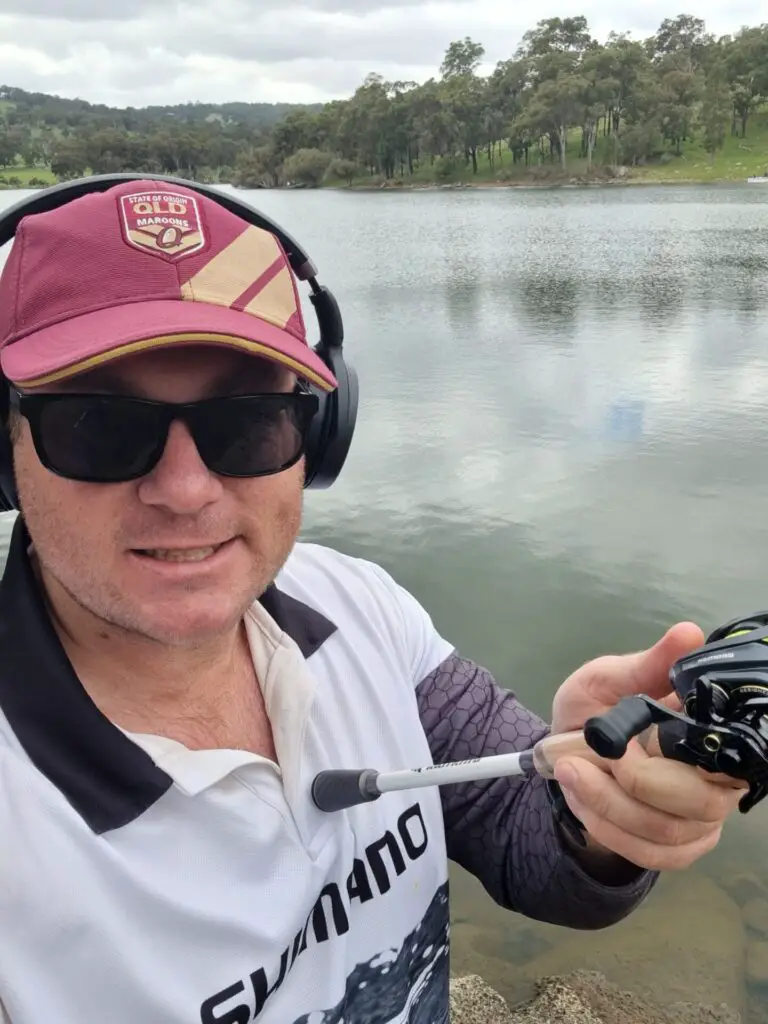Pro bass anglers use baitcasters for their superior accuracy, control, and power, allowing precise casts into tight spots, efficient handling of heavy lures, and greater line capacity. Baitcasters also excel in retrieving larger fish and provide better leverage, making them a preferred choice for bass fishing.
When it comes to competitive bass fishing, those that compete at the highest level of the sport require the very best out of their gear and tackle. If you’ve ever watched any professional bass fishing tournament on television, you’ve probably noticed that all of them use baitcasters the majority of the time.
This is because baitcasters present a number of significant advantages when compared to spinning or spincast reels. In this article, I’ll explain why pro bass anglers use baitcasters and discuss the advantages that a quality bass baitcasting reel provides in more detail.

Table of Contents
More Distance
One of the most prevalent reasons why professional bass anglers use baitcasters is to get more distance out of each cast. While it is true that baitcasting reels are not great for casting lightweight lures in most cases, they are excellent when it comes to getting much more distance with many of the lures used in bass fishing.
A baitcaster is capable of getting a lot more distance because of the way the reel is designed. With the spool situated in a horizontal alignment, the line is allowed to fly off the spool more freely than it does with a spinning reel. With a spinning reel, the line has to come off the reel in a way that makes it travel away from the reel in a forward direction.
Baitcasters are designed in a way that eliminates as much friction as possible and, in most cases, lets anglers cast a bit farther than they could with a spinning reel.
For pro bass anglers, being able to cast farther means they will be able to cover more water. In many situations, pro anglers spend every minute they have repeatedly casting their lure over as much water as possible in an effort to locate fish and get a bite.

Greater Line Capacity
Another important advantage you get with baitcasters is the ability to have more line on the spool. This might not seem like a major advantage, but it cuts down on the amount of time you might have to spend putting more line on your spool. This means you’ll be able to have a lot more line on your reel if you’re fishing with a heavier pound test.
Gear Ratios
Having a faster gear ratio is one of the main reasons some pro bass anglers opt for a baitcaster over a spinning reel. Beginner and novice anglers might not grasp the importance of a faster gear ratio until they have actually fished with a baitcaster that’s more than 7.1:1.
Having the ability to gather more line onto the reel with each turn of the handle means an angler can keep their line tight with less effort than they would with a slower 5.2:1. This faster gear ratio is perfect for certain lure presentations and rigs that require a stop-and-go retrieve. These include jerkbaits, topwater lures, finesse rigs, and anything else that might require you to twitch or pull the rod before reeling in the slack.
A faster gear ratio is also ideal for times when you want to retrieve a spinnerbait, crankbait, or any other lure at a quicker pace. If you’re more interested in having a slower gear ratio that allows you to have more cranking power, you can easily find a baitcasting reel that offers the same gear ratio you’re looking for.
I have also written an article explaining how fast you should fish a crankbait.
Greater Accuracy
One of the most important reasons why pro bass anglers prefer to use a baitcaster over a spinning or spincast reel comes down to the level of pinpoint accuracy they’re able to achieve with baitcasting setups. A baitcaster is more accurate because the angler is able to have a greater amount of control over their lure since they’re able to stop the spool’s rotation with their thumb.
This might not seem like a notable difference to some anglers as you can get decent accuracy with some of the newer spinning reel models that are now available in today’s fishing industry, but any professional angler will tell you that a baitcaster is far superior in terms of precision casting.
Being able to cast with pinpoint accuracy is crucial to the overall success of professional bass anglers as they are typically fishing in or very close to different types of structure and cover. The last thing an pro angler wants to do is get their hook snagged on a branch or other type of structure.
Getting snagged on something like this means you’ll risk having to break the lure off, meaning you will probably lose it. It also might cause you to make too much disturbance in the water, which is going to spook off any fish that are in the area.
In addition to these issues, getting your line snagged is a problem that takes precious time to fix. If there’s one thing that professional bass anglers can’t get enough of, it’s time on the water between the moment they launch and weigh ins.

Better Sensitivity
Being able to detect those subtle pecks or bites you sometimes get when bass fishing is a major advantage that baitcaster reels deliver when compared to spinning reels. Pro bass anglers know that baitcasting reels offer much more sensitive capabilities and are better for a number of different lures and rigs.
The baitcaster is able to have more sensitivity for a few different reasons. Many baitcasting reels are made with a much more precise gearing system, as well as a rigid body, which means you’ll have the ability to feel anything tugging on the end of your line. Spinning reels sometimes have just a bit of play in them that makes it much harder to feel the same type of bites.
A baitcaster is also designed in a way that makes it much better in terms of sensitivity based on the orientation of the reel and the fact that it sits on top of the rod instead of underneath it. Spinning reels are attached to the rod in a way that puts them underneath it, which means the line hangs down off of the rod itself.
A baitcaster is situated on top of the rod, meaning the line sits on top and has more points of contact with the rod. The fact that the line touches the rod and runs the length of the baitcaster rod makes it much easier to feel anything pulling on the line.
Eliminates Line Twist
The overall design of the spinning reel is one which leads to more line twist simply because the line is constantly being twisted and wrapped around the bail wire or the spool itself while you’re reeling in your lure. A baitcaster collects line using a number of components that help to virtually eliminate any line twist.
Baitcaster reels have a line guide that works to effectively collect and disperse the line onto the spool in a way that ensures the line won’t bunch up on one end of the spool. In addition to the line guide, the baitcasting reel’s spool alignment makes it much easier to collect the line without any twists.
Works Well With Heavier Lures
One of the most common reasons why pro bass anglers use baitcasters is because they are much better-suited for fishing with heavy lures. As most anglers know, in order to catch trophy-sized bass, you usually have to use bigger, heavier lures and rigs. If you’re going to be fishing with larger, heavier lures, it’s crucial that you have the right tackle to do so.
Lighter Designs
Professional bass anglers usually spend many days at a time out on the water, casting over and over again in search of the fish they’re after. This repeated casting can result in a serious amount of fatigue in the hands, wrists and arms of the angler, no matter how experienced they might be.
A baitcaster reel is usually much lighter than most spinning reels, which means it’s much easier to cast for hours on end, day after day. Many new premium baitcasting reel models are made out of incredibly lightweight material like magnesium, which makes them much lighter than any other reel while also delivering a higher amount of durability.
Conclusion
There are some instances where a professional bass angler might want to use a spinning reel instead of a baitcaster. However, for the majority of the time they spend on the water, a baitcasting reel is simply superior in almost every way. Pro bass anglers have to rely on their gear and equipment in order to have success on the tournament circuit and fishing with the reel that gives them the best possible advantage is vital if they want to come out on top.
